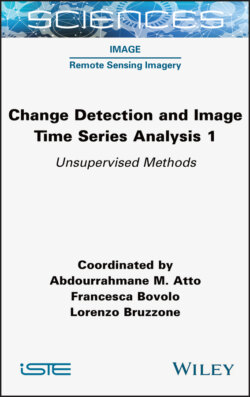Читать книгу Change Detection and Image Time-Series Analysis 1 - Группа авторов - Страница 13
1.1. Introduction
ОглавлениеRemote sensing satellites have a great potential to recurrently monitor the dynamic changes of the Earth’s surface in a wide geographical area, and contribute substantially to our current understanding of the land-cover and land-use changes (Bruzzone and Bovolo 2013; Song et al. 2018; Liu et al. 2019c). Scientifically understanding land changes is also essential for analyzing environmental evolution and anthropic phenomena, especially when studying the global change and its impact on human society. Thanks to the satellite revisit property, both long-term (e.g. yearly) and short-term (e.g. daily) satellite observations produce a huge amount of multitemporal images in the data archive (Liu et al. 2015). Based on the analysis of multitemporal data, land-cover changes can be automatically discovered and detected, where knowledge of changes can also be acquired. This becomes an important and complementary way of optimizing the traditional in situ investigation, which is often very costly and labor-intensive. In particular, in some cases such as in a natural disaster scenario, it is very difficult or even impossible to conduct field investigations. Change detection (CD) is the process of identifying change and no-change regions on the Earth’s surface by analyzing images acquired from the same geographical area at different times (Singh 1989; Coppin et al. 2004; Lu et al. 2004; Liu et al. 2019c). Therefore, automatic and robust techniques need to be designed to effectively discover, describe and detect changes that occur in multitemporal remote sensing images. In the past decades, CD has become an increasingly active research field and has been widely applied in various remote sensing applications, such as deforestation, disaster evaluation, urban expansion evolution and environment and ecosystem monitoring (Bovolo and Bruzzone 2007a; Bouziani et al. 2010; Du et al. 2012; Khan et al. 2017; Liu et al. 2020b).
Basically, CD techniques are developed based on specific remote sensing satellite sensors. In the literature, many excellent articles focused on the discussion of CD problems in different types of satellite sensors: for example, CD in multispectral images (Lu et al. 2004; Ban and Yousif 2016), SAR images (Ban and Yousif 2016) and hyperspectral images (Liu et al. 2019c), as well as in Lidar data (Okyay et al. 2019). Among different sensors mounted on the EO satellites, multispectral scanners can acquire images with both high spatial resolution and wide spatial coverage. In the past decades, due to data availability, multispectral remote sensing images such as Landsat and Sentinel serials contributed the main data source for the Earth’s surface monitoring and CD applications (Du et al. 2013; Liu et al. 2020a). However, with the increasing high quality and spatial resolution in new multispectral sensor images, especially for very high resolution (VHR) images, it is necessary to design advanced CD techniques that can deal with more complex change patterns presented in a more complex CD scenario.
In recent years, many CD methods have been developed for multispectral images, most of which focus on improving the automation, accuracy and applicability of CD (Leichtle et al. 2017; Liu et al. 2017a, 2019b; Wang et al. 2018; Saha et al. 2019; Wei et al. 2019). In general, according to the automation degree, they can be grouped into three main categories: supervised, semi-supervised and unsupervised methods. Usually, supervised CD approaches have better performance with higher accuracy by taking advantage of certain robust supervised classifiers (Wang et al. 2018). However, their implementation relies on the availability of ground reference data, which is often difficult to collect in most practical cases. Semi-supervised CD approaches start from limited training samples or partial prior knowledge learned from the single-time image, where the active learning or transfer learning algorithm can usually be applied to increase the sample representation (Liu et al. 2017b, 2019a; Zhang et al. 2018; Tong et al. 2020). In contrast, unsupervised approaches have higher automation without relying on the availability of ground reference data or prior knowledge (Liu et al. 2017a, 2019b; Saha et al. 2019). Therefore, the analysis in the unsupervised CD case is mainly data-driven and is actually more challenging than the other two tasks. However, from a practical application point of view, it is definitely more attractive due to its simplicity and high automation.
In this chapter, we focus on the unsupervised CD problem in multitemporal multispectral images. In particular, we investigate and analyze the spectral–spatial change representation for addressing the important multiclass CD problem. To this end, two approaches are developed, including a multi-scale morphological compressed change vector analysis and a superpixel-level multiclass CD. By taking advantage of the spectral and spatial joint analysis of change information, both approaches show higher performance than the compared state-of-the-art methods. Experimental results obtained from two real multispectral datasets confirmed the effectiveness of the proposed approaches in terms of higher accuracy and efficiency of CD.
The rest of this chapter is organized as follows. Section 1.2 points out the key concepts and challenges in unsupervised CD, and especially reviews the current development of spectral–spatial unsupervised CD techniques. Section 1.3 describes the two proposed unsupervised multiclass CD approaches in detail. Dataset description and experimental setup are provided in section 1.4. Experimental results and discussions are present in section 1.5. Finally, section 1.6 draws the conclusion of this chapter.
